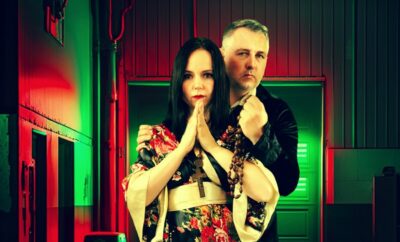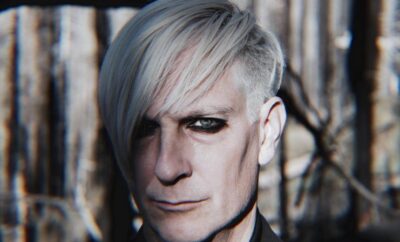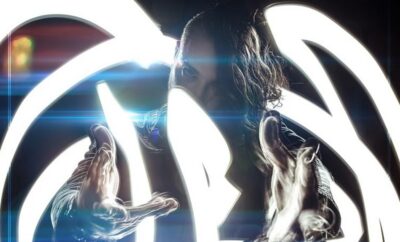
Interviews
FJØRA – The Sondheim Series
By: Lisa Steinberg
Q) How would you describe your sound?
A) I love to create in cinematronic (cinematic electronic), orchestral, contemporary polytextural, hybrid-synth, trailerization and vocalize sonic spaces.
Q) Who are some of your musical influences?
A) I draw inspiration from a wide gamut of musical influences – from classical to cinematic/score to alternative to pop. Some constants for me (to listen to) are Bjork, Danny Elfman, Philip Glass, Thomas Newman, anything Studio Gibli (Kim’s Delivery Service!) and Rachel Portman. I’m listening to a lot of Marina, Elton John and K Flay these days. John Williams is always there on my playlist. So, is Mychael Danna.
Q) Your new EP The Sondheim Series releases soon. What is it about this incredible composer that means so much to you?
A) I feel that Sondheim’s music and writing changed the landscape for how musicals and music storytelling could look – the idea of embracing the beauty of the “tangent” – the culmination of both dissonance and consonance, underlying tension, throughout a song or piece of music work. I first heard “Giants in the Sky,” a Sondheim piece of work, when I was a young child. I remember getting goosebumps when I heard the punctuating rhythmic orchestral stabs following “there are giants in the sky!” – it was a revelatory experience and really stuck with me. It was the dramatic undercurrent and unfolding of a song – the ability to capture a listener’s attention the entire time a run-on style phrase unfolds. Genius.
Q) What do you think it is about his music that fans connect to?
A) I think it’s the embracing of the creative tangent; it feels very evocative and emotionally complex. Additionally, there is a darkness which underlines his musical style…it feels honest, not just a sugar-coated, over-produced version of what life “should be.” It allows for celebration of flaws, the ugly, the nitty gritty – human nature, which can often be satirical. Sondheim’s own lyrical direction is rooted in the ideology of covering a wide gamut before arriving at the destination – covering all bases, uncovering every rock and turning over every stone before unequivocally (and indisputably) landing at the truth of it all…Somehow, he manages to convey emotional turmoil, peace, inner conflict, external curiosity, stillness and chaos, and have it all connect under one overarching vision. It seems that it is almost inside the niche and unpredictable that he obtains a sonic sense of home, familiarity and thus security. Relatability is a focal piece of the musical puzzle realized through unorthodox experimentation, and again, through the embracing of the tangent.
Q) How did you decide on the Sondheim songs that you wanted to cover? I imagine the process was quite difficult!
A) Yes, it really was! There are so many great songs to choose from. “Giants in the Sky” was the first piece that I decided to reimagine apart of the Sondheim Series; originally composed and written by Stephen Sondheim a part of the musical Into the Woods. It’s one of the first Sondheim songs that really gripped me early on in life…embodying all the harmonic, melodic, rhythmic and lyrical “Sondheim signatures” that demonstrates that there is immense beauty in the creative “tangent.” “Giants in the Sky” is the quintessential dreamer’s song: an ode to the child which craves adventure, the unknown and climbing the beanstalk to a new, foreign land. This is one of the first Sondheim songs I heard that profoundly touched me and impacted me on an emotional level.
“Children Will Listen” is another Sondheim song which carries a lot of weight to me. Children are a symbol of purity, innocence and vulnerability…beyond this, they are perfectly malleable creations, always listening, absorbing, evolving and being affected. “Children Will Listen” is a special song because it touches on this vulnerability and explores the space of who impacts a child, what influences a child’s being – the idea that there is great power and great responsibility in looking after a child and being in a child’s presence generally. In its original form, Sondheim uses contrasting key changes and chromatically infused melodies which convey an endless, ongoing momentum tying to a child’s emotional and physical journey. Again, the “embracing of the creative tangent” and following the tangent “down the rabbit hole” is painted throughout the song. Yet, with repetitive and cyclic rhythmic elements he connects all of these seemingly wandering ideas, creating a thread of commonality and thus anchorage for the whole of the song itself. There is a balance between light and dark in Sondheim’s works and this song embodies this balance poignantly. If anything, the darkness underlying the song acts as a bridge to the light because without it the light in question would not exist. I wanted to take this song structure framework and play off of it further, creating and extending instrumental interludes, highlighting juxtaposing sections with modulations and meter changes and striving to underscore the brilliance of Sondheim’s interpretation of what a (musical) song can take form as.
Q) Which of the songs that you covered are a personal favorite for you?
A) I think honestly both are – they both hold special particular meaning.
Q) You created “Maybe” in a Sondheim style. Talk about the process you had for creating this beautiful track.
A) Thanks so much. I’m so glad “Maybe” resonates for you. Well, “Maybe” was composed and orchestrated in the style of Stephen Sondheim; the harmonic and melodic direction which unfolds over the course of this song was crafted in a similar vein to that of Sondheim’s musical style (embracing the tangent!) This song is about the possibility of maybe; maybe something wonderful can happen, maybe there is a chance, maybe anything is possible. Sondheim’s own lyrical direction is rooted in the ideology of covering a wide gamut before arriving at the destination, covering all bases, uncovering every rock and turning over every stone before unequivocally (and indisputably) landing at the truth of it all…
Respectively, “Maybe” was created with the idea of the “niche space” in mind; inhabiting a place with an abundance of meaning and a myriad of avenues to explore. Following tangents and elusive language that is simultaneously specific and universal; can be perceived in multiple ways and allows for room of interpretation. Really, the one succinct, overarching idea that ties all of “Maybe” together is the question of possibility itself, which can be demonstrated in the tail-end bridge lyrics: “…but what can be true? What could be truth? Maybe it’s me, maybe it’s you.”
Through this style of lyrical unfolding and constantly developing harmonic, melodic and rhythmic elements throughout, the creative process of “Maybe” was very enlightening, enjoyable, and almost cathartic for me. It broke free of more standardized song structural techniques and frameworks in general, granting permission to chase thoughts and runaway moments, highlight emotional shifts and ultimately let the song’s direction come from the song itself.
What was interesting about the creative process of “Maybe” was that it was never made quite clear who the song was directed towards, or who it was being sung to. Maybe it’s almost poetic that this question will never be quite answered – maybe that’s the point of arrival in the end. Although filled with tension and ups and downs, the concept of hope for something more is maintained sonically and lyrically throughout “Maybe,” it’s my way of trying to honor the balance of dark and light (albeit reminiscence) which exists so beautifully across the massive body of work of Stephen Sondheim.
Q) How much of a hand do you have in the production of your music?
A) Both hands! Ha. I am a composer, producer, artist, songwriter – on this project I am the executive producer: I produced out all the elements in the initial demo pieces (so, sample sounds for all orchestral elements which I then used to notate/orchestrate instrumental parts for the orchestra and choral parts for the choir), then produced all the instrumental parts and choir/my vocals together before they went to mix.
Q) Where are some of your favorite places to perform and what makes those locations so significant to you?
A) I’ve gotten to perform at some amazing venues over time – some great experiences for me were for the Guild of Music Supervisors (where I gave a showcase), the Rogers Dome in Toronto and the Pan Am Tournament Games. These were all significant to me because I remember the energy being so positive and receptive from the audience. Also, location-wise the Rogers Dome is based in my hometown and was for an NBA game between the Raptors (the Toronto home-team) and New York, so that was pretty special. It was also with my two sisters, which made it extra meaningful!
Q) Who would you most like to collaborate with on a song in the future?
A) There is such a range from Aurora to Sofi Tukker to Isobel Waller-Bridge to Emile Mosseri. Nicholas Brittel to Sam Phillips to Tom Mizer & Curtis Moore (songwriters behind “The Marvellous Mrs. Maisel”). Atticus Ross and Trent Reznor, Jonny Greenwood and Lady Gaga. The list is literally so wide and varied. (This is also like a “wish list,” yeah? Like a “let’s manifest this” list?)
Q) You’ve had music featured in several TV series over a number of networks such as “Motherland: Fort Salem” and “Love is Blind.” Plus, there is the trailer for the game Fortnite and even for the store Marshalls. What does this accomplishment mean to you?
A) I’ve been very fortunate to have had my music gain traction within the Film/TV/ advertising and video game spaces for sure. Some of my personal favs have been the theme song “Deja Vu” for Playstation video game series “Deathloop,” reimagining Linda Perry’s “What’s Up” for Blumhouse and creating the custom music for Adidas Women’s “Support is Everything” international campaign with co-composer Angela Sheik. I think above all, these moments are accomplishments of personal growth, development, collaboration and strengthening relationships to me. With every “accomplishment” comes a marker for how much I’ve grown, learned and honed my craft, honored myself and my colleagues, and continue to forge a pathway forward for myself in the landscape of the music industry as a female music maker.
Q) You are a part of social media. Why is that such an important way for you to connect with your fans?
A) Social media is an interesting beast – there are definitely its ups and downs. For me, I’m grateful that I can use social media to maintain and gain new connection with fans, friends, and honestly – family! Ha. Social media, at least in the industry that I operate within, has really become like the modern-day resume; it’s where anyone can “check you out” online and see what you’ve been working on, what sort of style(s) you can create in, and a sort of makeshift “calling card.” I will add, time away from social media is something I feel is strongly significant and important for mental health preservation too – sometimes disconnecting online for a little bit enables one to reconnect in real life – to themselves and the people around them.
Q) What would you like to say to everyone who is a fan and supporter of you and your work?
A) Thank you, a million times over. I couldn’t do any of it without you!
Explore The Sondheim Series





You must be logged in to post a comment Login